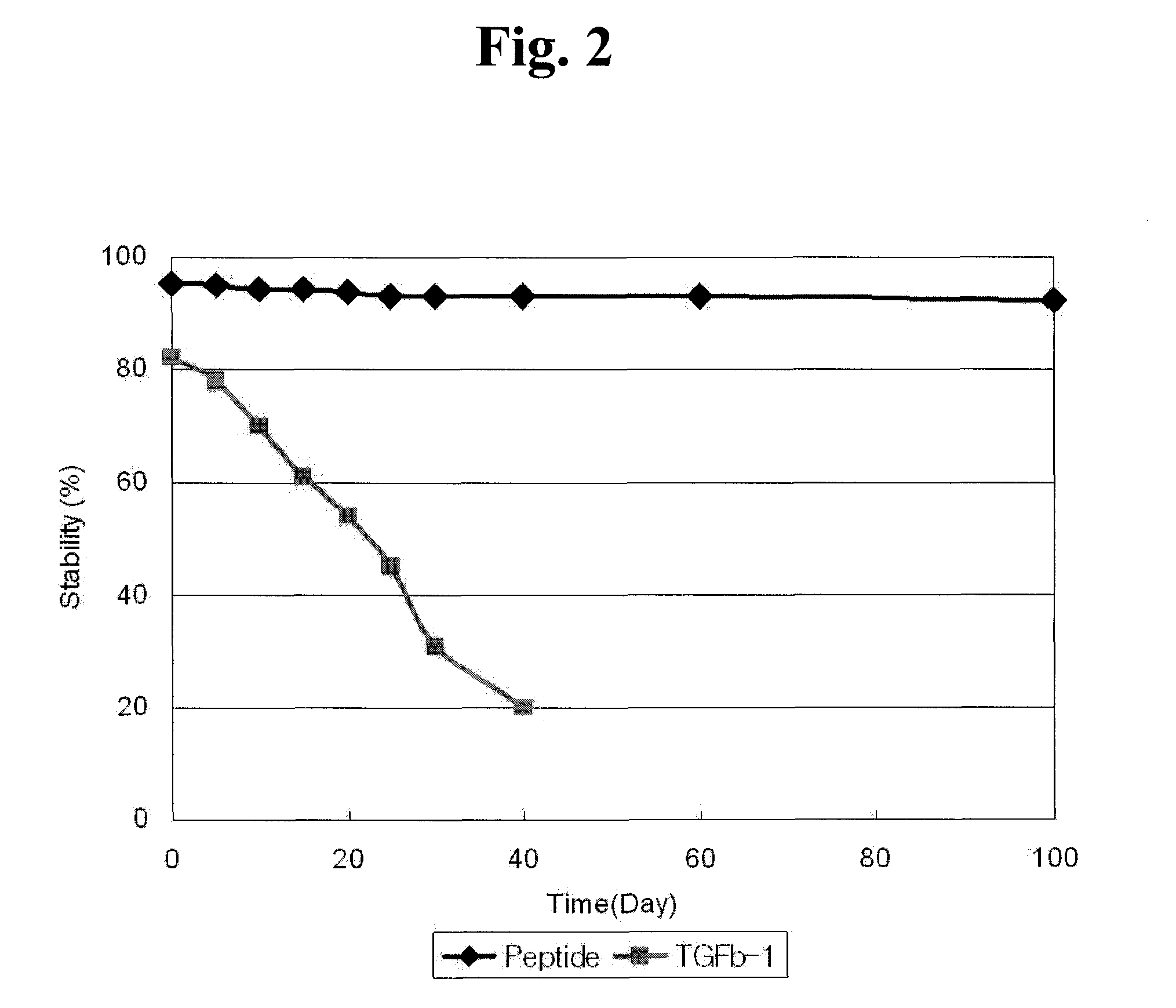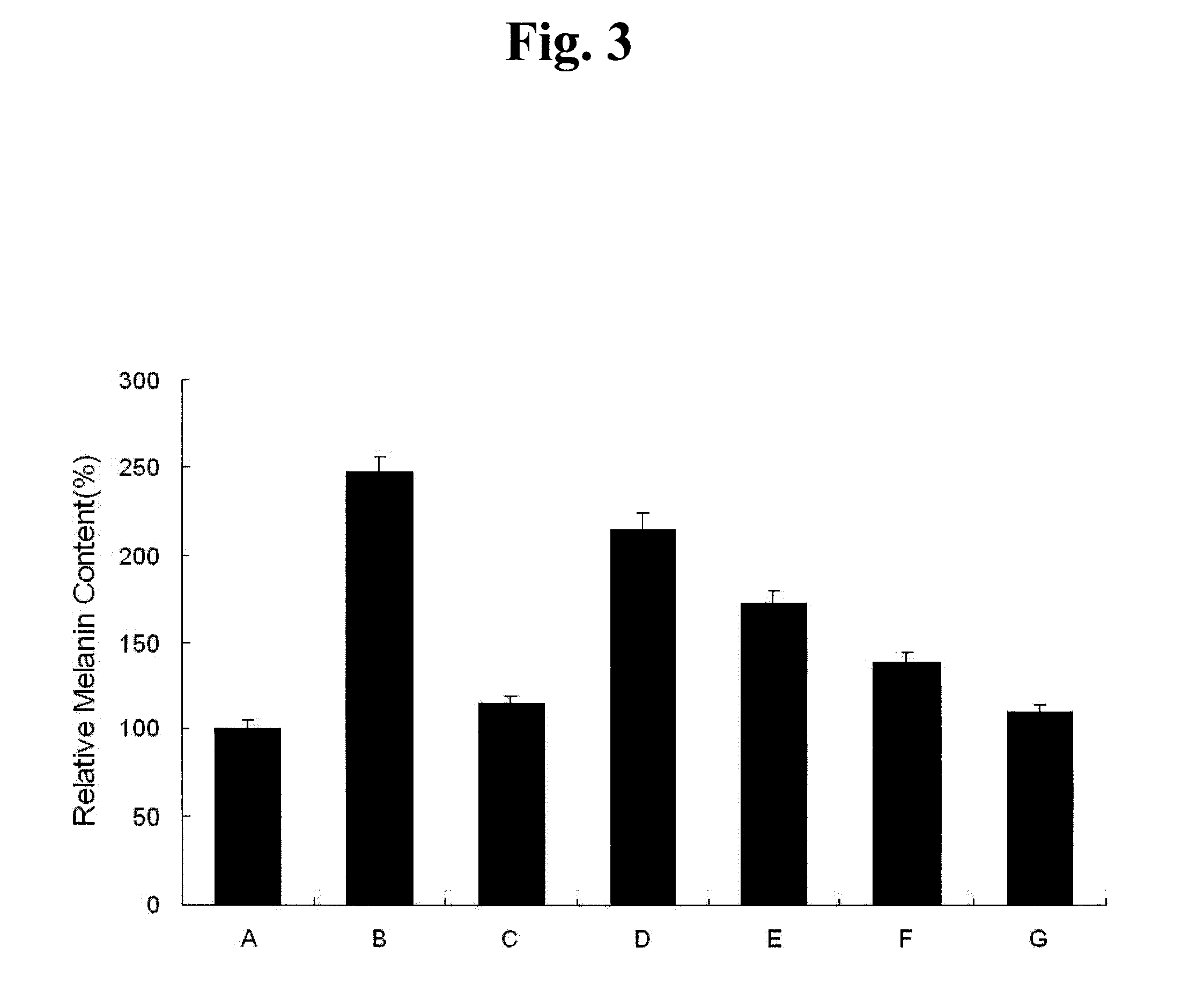TGFP-CAP peptide and its uses
a peptide and cap technology, applied in the field of peptides, can solve the problems of poor expression, high production cost, and unwidened utilization and application of the cap peptide, and achieve the effects of improving the sensitivity of the cap peptide to the environment, and improving the sensitivity of the cap peptid
- Summary
- Abstract
- Description
- Claims
- Application Information
AI Technical Summary
Benefits of technology
Problems solved by technology
Method used
Image
Examples
example 1
Synthesis of NH2-Ile-Trp-Ser-Leu-Asp-Thr-Gln-Tyr-Gly(n)-Arg-Gly-Asp-OH (SEQ ID NO:32)
[0081]700 mg of chloro trityl chloride resin (CTL resin, Nova Biochem Cat No. 01-64-0021) were introduced into a reactor, to which 10 ml of methylene chloride (MC) were added, followed by agitation for 3 min. After removing solution, 10 ml of dimethylformamide (DMF) were added to the resultant and then agitation was carried out for 3 min, after which the solvent was removed. 10 ml of dichloromethane solution were added to the reactor and 200 mmole of Fmoc-Asp(otbu)-OH and 400 mmole of DIEA were then added to the reactor, after which the mixture was dissolved by agitation and reaction was then undertaken with agitating for 1 hr. After washing, the resin was reacted with a mixture of methanol and DIEA (2:1) in MC for 10 min, and then washed with excess of MC / DMF (1:1). After removing solution, 10 ml of DMF were added to the resultant and agitation was performed for 3 min, followed by removing the solv...
example 2
Stability Analysis of Tridecapeptide
[0082]To evaluate stability of the purified tridecapeptide, NH2-Ile-Trp-Ser-Leu-Asp-Thr-Gln-Tyr-Gly-Gly-Arg-Gly-Asp-OH, it was dissolved in 50 mM Tris-HCl (pH 8.0) to a concentration of 10 μg / ml. A recombinant TGF-β1 (Sigma) produced by E. coli was prepared as a control in the same buffer to a concentration of 1 μg / ml. The prepared solutions were introduced into glass vials and kept to stand at 37° C. Afterwards, the solutions were taken on days 0, 1, 10, 25, 50, 75 and 100 and subjected to a MTT assay (Scudiero, D. A., et al. Cancer Res. 48:4827-4833 (1988)) using NIH-3T3 cells (Korean Cell Line Bank) for determining their remaining activity (FIG. 2). The results were given as relative values to the activity (100%) of sample taken on day 0.
[0083]As represented in FIG. 2, the activity of the recombinant TGF-β1 was sharply decreased with the lapse of time. In contrast, the activity of the present tridecapeptide was shown not to be decreased over ti...
example 3
Preparation of Nano Peptides
[0084]50 mg of the tridecapeptide synthesized was dissolved in 500 ml of distilled water. The peptide solution was mixed with 5 g lecithin, 0.3 ml sodium oleate, 50 ml ethanol and a small amount of oils and its volume was adjusted with distilled water to 1 L. The resulting solution was subjected to a microfluidizer under high pressure for emulsification, thereby providing nanosomes having 100-nm size. The nanosomes were prepared to have a final concentration of about 50 ppm and used as ingredients for cosmetics.
PUM
| Property | Measurement | Unit |
|---|---|---|
| molecular weight | aaaaa | aaaaa |
| total volume | aaaaa | aaaaa |
| concentration | aaaaa | aaaaa |
Abstract
Description
Claims
Application Information
 Login to View More
Login to View More - Generate Ideas
- Intellectual Property
- Life Sciences
- Materials
- Tech Scout
- Unparalleled Data Quality
- Higher Quality Content
- 60% Fewer Hallucinations
Browse by: Latest US Patents, China's latest patents, Technical Efficacy Thesaurus, Application Domain, Technology Topic, Popular Technical Reports.
© 2025 PatSnap. All rights reserved.Legal|Privacy policy|Modern Slavery Act Transparency Statement|Sitemap|About US| Contact US: help@patsnap.com



